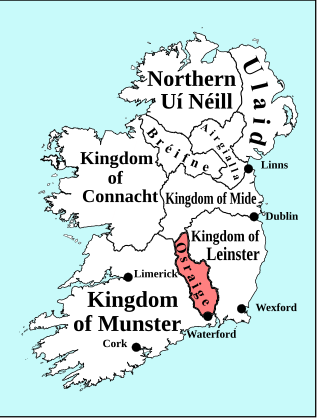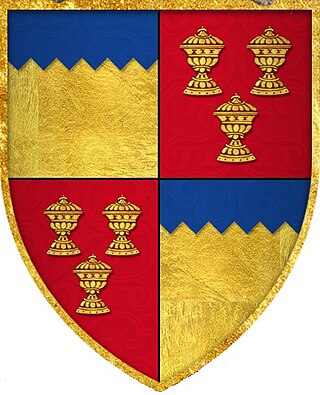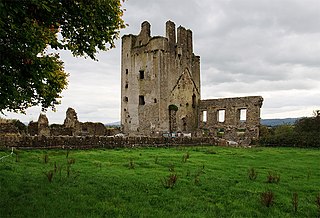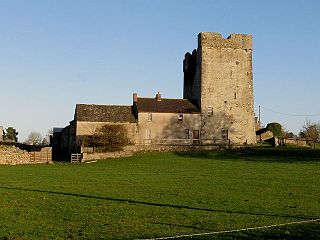
The kings of Osraige reigned over the medieval Irish kingdom of Osraige from the first or second century AD until the late twelfth century. Osraige was a semi-provincial kingdom in south-east Ireland which disappeared following the Norman Invasion of Ireland. A number of important royal Ossorian genealogies are preserved, particularly MS Rawlinson B502, which traces the medieval Mac Giolla Phádraig dynasty back through Óengus Osrithe, who supposedly flourished in the first or second century. and one in the Book of Leinster. Recent analysis of ninth and tenth century regnal succession in Osraige has suggested that in peaceful times, kingship passed primarily from eldest to youngest brother, before crossing generations and passing to sons and nephews.

Piers Butler, 8th Earl of Ormond, 1st Earl of Ossory also known as Red Piers, was from the Polestown branch of the Butler family of Ireland. In the succession crisis at the death of Thomas Butler, 7th Earl of Ormond he succeeded to the earldom as heir male, but lost the title in 1528 to Thomas Boleyn. He regained it after Boleyn's death in 1538.
John Butler, 17th Earl of Ormonde, 10th Earl of Ossory (1740–1795) was an Irish peer and Member of Parliament (MP). He became a Protestant in 1764. He was an Irish MP, representing Gowran between 1776 and 1783, and Kilkenny City between 1783 and 1792. In 1791, his right to the peerage was acknowledged in the Irish House of Lords and he became the 17th Earl of Ormond.
Sir Walter Butler, 11th Earl of Ormond and 4th Earl of Ossory (1559–1633), succeeded his uncle Black Tom, the 10th earl, in 1614. He was called "Walter of the Beads" because he was a devout Catholic, whereas his uncle had been a Protestant. King James I intervened and awarded most of the inheritance to his uncle's Protestant daughter Elizabeth. Ormond contested the King's decision and was for that insolence detained in the Fleet Prison from 1619 until 1625 when he submitted to the King's ruling. He then found a means to reunite the Ormond estate, by marrying his grandson James, who had been raised a Protestant, to Elizabeth's only daughter.

Baron Upper Ossory was a title in the Peerage of Ireland. It was created on 11 June 1541 for Barnaby Fitzpatrick. This was in pursuance of the Surrender and regrant policy of King Henry VIII. Under the policy, Gaelic chiefs were actively encouraged to surrender their lands to the king and then have them regranted (returned) under a royal charter if they swore loyalty to him. Those who surrendered were also expected to speak English, wear English-style dress, remain loyal to the Crown, pay a rent and follow English laws and customs, abjure the Roman Catholic Church, and convert to Henry's new Anglican Church.
Roland Eustace, 2nd Viscount Baltinglass of Harristown, County Kildare, Ireland, was born in 1505 and died in 1578. He was the son of Sir Thomas Eustace (1480–1549), 1st Viscount Baltinglass and Margaret Talbot, daughter of Sir Peter Talbot of Malahide Castle, County Dublin.
Connor O'Brien, 3rd Earl of Thomond also spelt Conor and called Groibleach, or the "long-nailed", fought his uncle Donnell over his father's succession during thirty years from 1535 to 1565. He was confirmed as 3rd Earl of Thomond in 1558 by the Lord Deputy of Ireland, Thomas Radclyffe, 3rd Earl of Sussex. O'Brien intrigued with fitz Maurice in 1569 during the 1st Desmond Rebellion and fled to France. He returned and was pardoned in 1571, being restored to his lands at the end of the rebellion in 1573.

Sir Edmund Butler of Cloughgrenan, was an Irish noble and the second son of James Butler, 9th Earl of Ormond and Lady Joan Fitzgerald. He was a scion of the House of Ormond, and a rebel against the Tudors.
Edmund Butler, 2nd Viscount Mountgarret, was the son of Richard Butler, 1st Viscount Mountgarret and Eleanor Butler.

John Butler of Kilcash was an Irish landowner and soldier. A younger son of James Butler, 9th Earl of Ormond and brother of Thomas Butler, 10th Earl of Ormond, he received Kilcash Castle as appanage. He fought in the Desmond–Ormond conflict and was badly wounded in 1563, just before the Battle of Affane. He was the start-point of the Kilcash branch of the Ormonds and the father of Walter Butler, 11th Earl of Ormond.

Kilbline Castle is a fortified 16th century tower house in County Kilkenny in Ireland. It is set on the Kilbline Estate in the parish of Tullaherin, within the historical barony Gowran, approximately 1 mile southeast of Bennettsbridge. It is recorded as a protected (listed) structure by Kilkenny County Council.
Barnaby Fitzpatrick (c.1478–1575) was the last person to have claim to the kingship of Osraige; forfeiting his ancestral title in favour of being created the first Lord Baron Upper Ossory by King Henry VIII of England, by patent dated 11 June 1541, as part of the King's policy of Surrender and regrant. Barnaby Fitzpatrick was subsequently knighted on 1 July 1543.

Colonel Thomas Butler of Garryricken, also known as Thomas Butler of Kilcash was an Irish Jacobite soldier. He commanded a regiment, Thomas Butler's foot, during the Williamite War and fought at the Battle of Aughrim in 1691 where he was taken captive. His son John would, de jure, become the 15th Earl of Ormond.

Barnaby Fitzpatrick, 2nd Baron Upper Ossory, was educated at the court of Henry VIII of England with Edward, Prince of Wales. While he was in France, he corresponded regularly with King Edward VI. He was active in suppressing Wyatt's rebellion in 1553. He went home to Ireland, where he would have a lifelong feud with the Earl of Ormonde. His wife and daughter were abducted in 1573 by the Grace family, supposedly at Ormonde's instigation. He killed his cousin, the rebel Rory O'More in 1578.
Edmond Butler, 3rd/13th Baron Dunboyne (1595–1640) was an Anglo-Irish nobleman of the early seventeenth century. His short life was full of violence and disputes over the Dunboyne inheritance. His father was murdered when Edmond was a small child, and Edmond as an adult was forced to defend a lengthy lawsuit brought by his uncle, who sought to disinherit him. In 1627 he killed his cousin James Prendergast in a quarrel over a disputed inheritance. For this crime, he was tried by his peers for manslaughter, but was acquitted.

Mac Giolla Phádraig is a native Irish dynastic surname which translates into English as "Son of the Devotee of (St.) Patrick". In the medieval period, the Mac Giolla Phádraigs were hereditary kings of Osraige; today, the anglicised version of the name is commonly "Fitzpatrick".
Florence Fitzpatrick, 3rd Baron Upper Ossory, was the third son of Barnaby Fitzpatrick, 1st Baron Upper Ossory and his wife Margaret Butler, and inherited the title upon the death of his older brother Barnaby Fitzpatrick, 2nd Baron Upper Ossory in 1581. He married Catherine O'More, daughter of Patrick O'More of Abbeyleix, and had six children, including his son Teige, who succeeded as 4th Baron, and Joan who married John Butler of Dunboyne, by whom she was the mother of Edmond Butler, 3rd/13th Baron Dunboyne.
Barnaby Fitzpatrick, 5th Baron Upper Ossory was the son and heir of Teige Fitzpatrick, 4th Baron Upper Ossory.
Barnaby Fitzpatrick, 6th Baron Upper Ossory, was the heir and successor of Barnaby Fitzpatrick, 5th Baron Upper Ossory. The eldest son of Barnaby Fitzpatrick by his wife Margaret Butler, he took his seat in Parliament on 16 March 1639. He married Catherine Everard, daughter of Sir Edward Everard, and his heir was his eldest son, Barnaby.
Barnaby Fitzpatrick, 7th Baron Upper Ossory, was the eldest son, heir and successor of Barnaby Fitzpatrick, 6th Baron Upper Ossory by his wife Catherine Everard.








